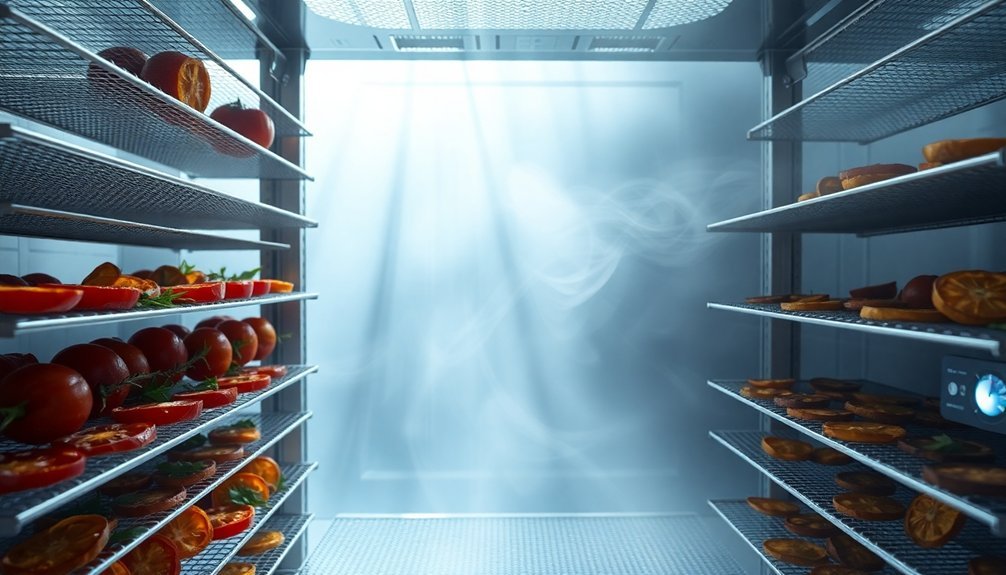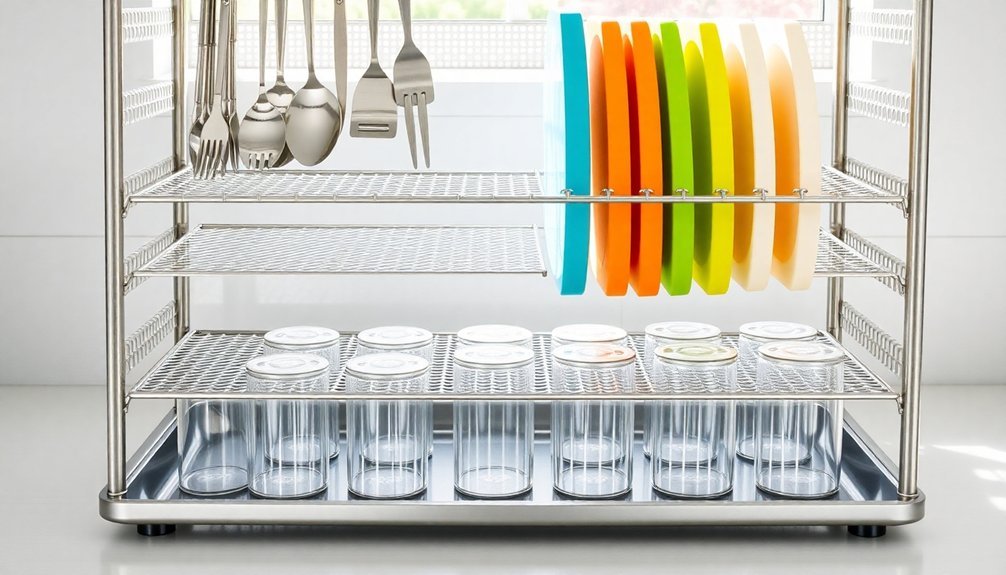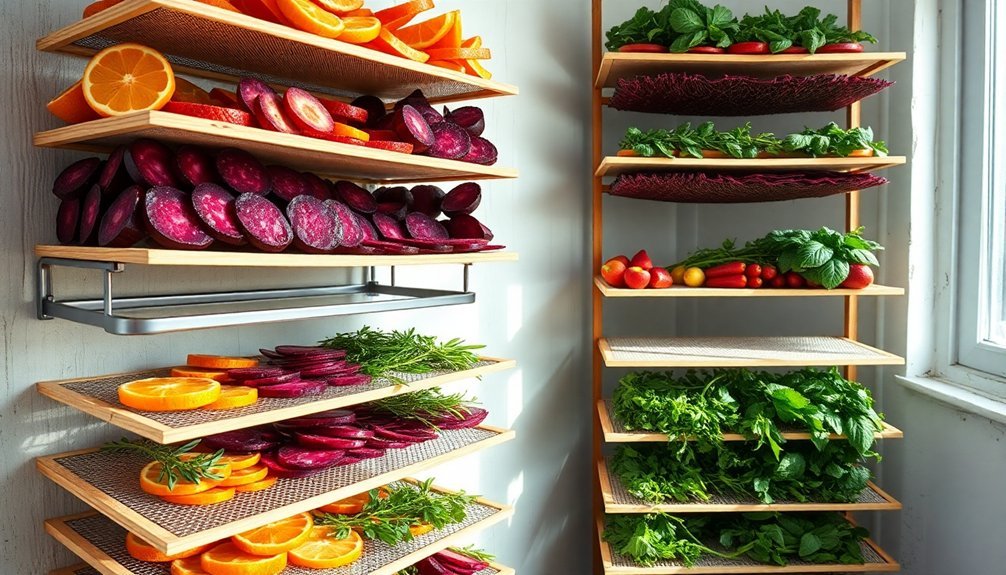Your perfect food drying station needs several essential components working together. You'll want heavy-duty stainless steel or aluminum racks with adjustable shelving to accommodate different food sizes and prevent wet nesting. The station should maintain temperatures between 65-75°F with relative humidity of 40-60%, controlled by high-volume fans and proper ventilation systems. Make sure you've got adequate spacing between items and good airflow management through well-designed racks and filters. Don't forget about easy-to-clean surfaces and maintenance access points. Understanding these key elements will help you build a drying station that maximizes efficiency and food safety.
Essential Parts of Drying Stations

What makes a food drying station truly efficient? It starts with essential racking systems that come in various sizes to meet your specific needs.
You'll want racks that can accommodate different items, from cutting boards to steam pans, with slots designed for proper spacing and airflow. Regular cleaning and maintenance is crucial to prevent mold growth and ensure optimal drying conditions.
Your drying station should feature heavy-duty construction, typically made from aluminum or stainless steel, ensuring long-term durability.
The racks must prevent wet nesting by keeping items upright, which is vital for proper drying and preventing bacterial growth.
You'll also need adjustable components that let you customize the space for different sized dishes and pans.
Don't forget to include drop-in racks for your bulkier items and sorting pegs to hold pans of various sizes.
Utensil drying grids are essential for keeping smaller items organized and easily accessible.
Consider adding mobile shelves with casters for flexibility in your workspace.
Finally, make sure you've got drip trays installed beneath the racks to catch water runoff and prevent hazardous floor conditions.
With these fundamental components in place, you'll have a drying station that's both functional and compliant with health regulations.
Location and Environmental Considerations
Your food drying station needs a consistent room temperature between 10°C and 20°C to guarantee ideal drying conditions and prevent moisture-related issues.
You'll want to position your drying station away from direct sunlight and heat-generating equipment like water heaters or steam generators.
Make certain you've got proper ventilation with adequate air exchange rates, and keep food items spaced apart to allow for free air circulation throughout your drying area.
The drying station should be located with easy access to kitchen prep areas to maintain an efficient workflow and minimize unnecessary movement.
Room Temperature Control Essentials
Successful food dehydration depends heavily on proper room temperature control and smart placement of your drying station.
You'll want to maintain room temperatures between 65°F and 75°F for the best drying results. Keep your dehydrator away from direct heat sources, including sunlight, radiators, and ovens, as these can interfere with consistent temperature control.
Position your dehydrator near a reliable power outlet on a stable, level surface where you can easily access the trays. The Parallexx airflow system requires adequate spacing to maintain even drying across all trays.
Don't place it near sinks or in humid basements, as moisture can greatly impact drying efficiency. You'll need to make sure there's enough clearance around the unit for proper air circulation.
Monitor your room's relative humidity using a hygrometer, aiming for levels between 40% and 60%.
If you're dealing with high humidity, consider using a dehumidifier to create ideal drying conditions.
Remember to adjust your dehydrator's thermostat settings based on both room temperature and the type of food you're processing.
After each use, let your unit cool down completely before storing dried foods to prevent moisture from reabsorbing into your finished products.
Ventilation and Air Flow
Beyond room temperature control, proper ventilation and air flow play a fundamental role in food dehydration success. You'll need to verify your drying station has continuous ventilation during operation, using either natural or mechanical methods to maintain ideal air quality and prevent contamination.
Your ventilation setup should include high-volume fans that mix the air effectively, preventing stagnant pockets where moisture can accumulate. Install air filters to keep unwanted particles from reaching your food, and consider using dehumidifiers to maintain suitable moisture levels.
You'll want to create a positive pressure environment using packaged air handling systems to keep contaminated air from entering your drying space. To maximize your drying station's efficiency, seal any unnecessary openings to reduce moist air infiltration.
If you're using mechanical exhaust systems, they must effectively remove vapors, heat, and any food-related odors. Don't forget to implement proper hood systems based on your specific drying needs.
Regular maintenance of your ventilation components is essential – you'll need to clean filters, check fan operations, and verify all systems are working together to maintain the clean, dry environment necessary for successful food dehydration.
Material Selection for Long Life

When choosing between steel and aluminum for your food drying station, you'll find that stainless steel offers superior durability and corrosion resistance while aluminum provides a lighter-weight solution that's naturally rust-resistant.
You'll want to take into account that stainless steel requires minimal maintenance and accounts for over 40% of dish rack sales, while aluminum makes up roughly 30% of the market due to its ease of handling and storage benefits.
To maximize corrosion protection, look for designs with elevated contact points, proper drainage channels, and protective coatings that prevent moisture from collecting on the surface.
Steel Vs Aluminum Benefits
Selecting the right material for your food drying station can greatly impact its longevity and performance. When choosing between stainless steel and aluminum, you'll need to evaluate several key factors that affect your drying station's efficiency and durability.
Stainless steel offers exceptional durability with its high tensile strength and resistance to bending. You'll benefit from its non-porous surface, which prevents bacterial growth and guarantees food safety. It's particularly valuable for its heat resistance and ability to maintain structural integrity under extreme temperatures.
While it's heavier, you won't need to worry about frequent replacements or repairs.
Aluminum presents a different set of advantages. You'll find it's considerably lighter, making it easier to adjust or relocate your drying station. It conducts heat more efficiently, allowing for quicker temperature changes and even heat distribution.
If you're working with a tighter budget, aluminum's lower initial cost makes it an attractive option. It's also more energy-efficient at lower temperatures, which can reduce your operating costs.
Evaluate your specific needs: if durability and hygiene are paramount, choose stainless steel; if weight and heat conductivity matter more, aluminum might be your better choice.
Corrosion-Proof Design Elements
Building a long-lasting food drying station demands careful attention to corrosion-proof materials and design elements. Your primary material choices should focus on fiberglass-reinforced plastic (FRP) or stainless steel, as both offer superior resistance to moisture, acids, and cleaning agents.
FRP provides smooth, non-porous surfaces that resist bacterial growth and withstands temperatures over 200°F, while stainless steel's durability guarantees it won't deteriorate under harsh conditions.
You'll want to incorporate polymer or epoxy coatings for additional protection. Polyurea coatings create nonporous surfaces that prevent food waste accumulation, while fluoropolymer coatings shield against harsh cleaners.
For drying racks and shelving, consider epoxy-coated surfaces or polypropylene components that resist humidity and corrosion.
Your design should emphasize seamless construction to eliminate exposed fasteners and problematic seams. Ascertain smooth surfaces throughout to prevent scale build-up and bacterial lodgment.
Don't forget to implement proper ventilation and air circulation features – they're essential for preventing moisture buildup and guaranteeing even drying. These elements working together will create a corrosion-resistant station that maintains its integrity through years of use.
Space-Efficient Design Elements
A well-designed food drying station maximizes every inch of available space through strategic vertical and horizontal planning.
You'll want to incorporate high-density vertical shelving that can accommodate 40-50% more storage capacity compared to traditional layouts, while keeping frequently used items within easy reach at lower levels.
Install adjustable shelving systems that you can customize based on your changing needs. These versatile components let you modify heights and configurations to accommodate different sized items, from small mod pans to larger drying racks.
You should maintain clear 3-foot-wide aisleways for safe movement and efficient workflow while positioning your drying station away from main kitchen production areas.
Consider implementing mobile shelving units that you can easily relocate as needed. These adaptable solutions help you maximize space utilization during peak periods and can be repositioned during slower times.
Don't forget to include compact, space-saving drying racks that can hold multiple items without cluttering your workspace. Position them strategically using point-of-use storage principles to enhance efficiency.
Remember to organize your layout using the first-in, first-out method to maintain proper stock rotation.
Air Flow Management Systems

Beyond optimizing your space layout, proper airflow management forms the backbone of an effective food drying station. You'll need to implement an innovative design that keeps air circulating efficiently in the processing zone while maintaining consistent velocity over product surfaces.
Using computational fluid dynamics (CFD) modeling, you can precisely plan your air distribution system to achieve ideal results. Your system should maintain a permanent balance between supply and return air, eliminating hot and cold spots that could compromise product quality.
You'll want to control the breakpoint where high and low velocity air meet, ensuring it stays at the intended location for repeatable results. Installing flow control valves will help you regulate conditions based on humidity and wet bulb temperature.
You can achieve significant energy savings by incorporating exhaust recirculation and optimizing parameters like chimney height and product load. This efficiency can reduce horsepower requirements by 20-25% compared to single-fan dehydrators.
Don't forget to equip your air handling units with MERV 7 prefilters and MERV 15 final filters to maintain hygiene standards and prevent condensation issues that could affect food safety.
Load Distribution and Support
Proper load distribution forms the foundation of a reliable food drying station. You'll need to understand how different loads affect your structure to maximize efficiency and safety. Your station's shelves and frame must handle both distributed and point loads while maintaining stability throughout the drying process.
Your drying station's structural integrity depends on three key elements:
- Material selection – Type 304 stainless steel and extruded aluminum channels provide the durability and corrosion resistance needed for long-term operation.
- Load calculation – Consider both rectangular loads from evenly distributed trays and triangular loads that might occur from uneven product placement.
- Support configuration – Implement proper cross bracing, reinforced tops, and strategic weight distribution to maintain balance.
You'll want to guarantee your station includes adjustable features and ergonomic design elements for easy handling. Heavy-duty swivel casters with locks provide mobility while maintaining stability when stationary.
The inclusion of wire dividers and interlocking solid panels helps distribute weight evenly across multiple levels, preventing strain on any single point of the structure.
Cleaning and Maintenance Protocols

Maintaining your food drying station's cleanliness is critical for food safety and equipment longevity. Before you start cleaning, unplug your dehydrator and disassemble all removable parts, including trays and mesh screens. Review your user manual for model-specific cleaning instructions.
You'll want to soak the removable components in warm, soapy water for at least 20 minutes. Use a non-scratch pad or soft bristle brush for gentle scrubbing. If you're dealing with stubborn residues, try Dawn Platinum Power Cleaner, Bon Ami Powder Cleaner, or Powdered Brewery Wash (PBW).
Don't use metal brushes or abrasive materials that could damage surfaces.
For the main unit, wipe down interior and exterior surfaces with a damp cloth and mild detergent. Be careful not to let water seep into electrical components, and keep air vents clear of debris. Pay special attention to the base, using a wet rag while avoiding direct water contact.
Once you've cleaned everything, dry all parts thoroughly with clean towels before reassembly.
Store your dehydrator in a cool, dry, well-ventilated space to prevent mold growth and guarantee it's ready for your next use.
Frequently Asked Questions
How Often Should Caster Wheels Be Lubricated for Optimal Performance?
You'll need to lubricate your caster wheels every six months under normal conditions. If you're using them in dirty or corrosive environments, increase frequency to monthly. Heavy industrial use requires lubrication every 2-3 months.
Can Multiple Tray Sizes Be Stored on the Same Drying Rack?
Yes, you can store multiple tray sizes on the same drying rack. Most models feature adjustable shelves and universal fits to accommodate various dimensions, from 10"x20" roast pans to 20"x22" bake pans.
What's the Recommended Distance Between Vertically Stored Trays?
You'll want to maintain about 1/4 inch (6mm) spacing between vertically stored trays. If you're using fans to enhance airflow, you can adjust this slightly, but don't compress trays too tightly together.
Do Temperature Fluctuations Affect the Rack's Structural Integrity Over Time?
You don't need to worry about temperature fluctuations damaging your rack's structure over time. The integrity depends more on your choice of materials and maintenance than on temperature changes during the drying process.
Are There Specific Weight Limits for Each Shelf Level?
You'll need to check your rack's manual for specific shelf-level weight limits. Most manufacturers list both per-shelf and total weight capacities. Don't exceed these limits to maintain safety and structural integrity.
In Summary
Your perfect food drying station isn't complete without regular upkeep and thoughtful design. You'll get the best results when you've balanced proper airflow, sturdy materials, and smart space management. Keep it clean, maintain even load distribution, and you'll enjoy consistent drying results for years to come. Remember, it's not just about the components – it's how they work together in your specific environment.





Leave a Reply